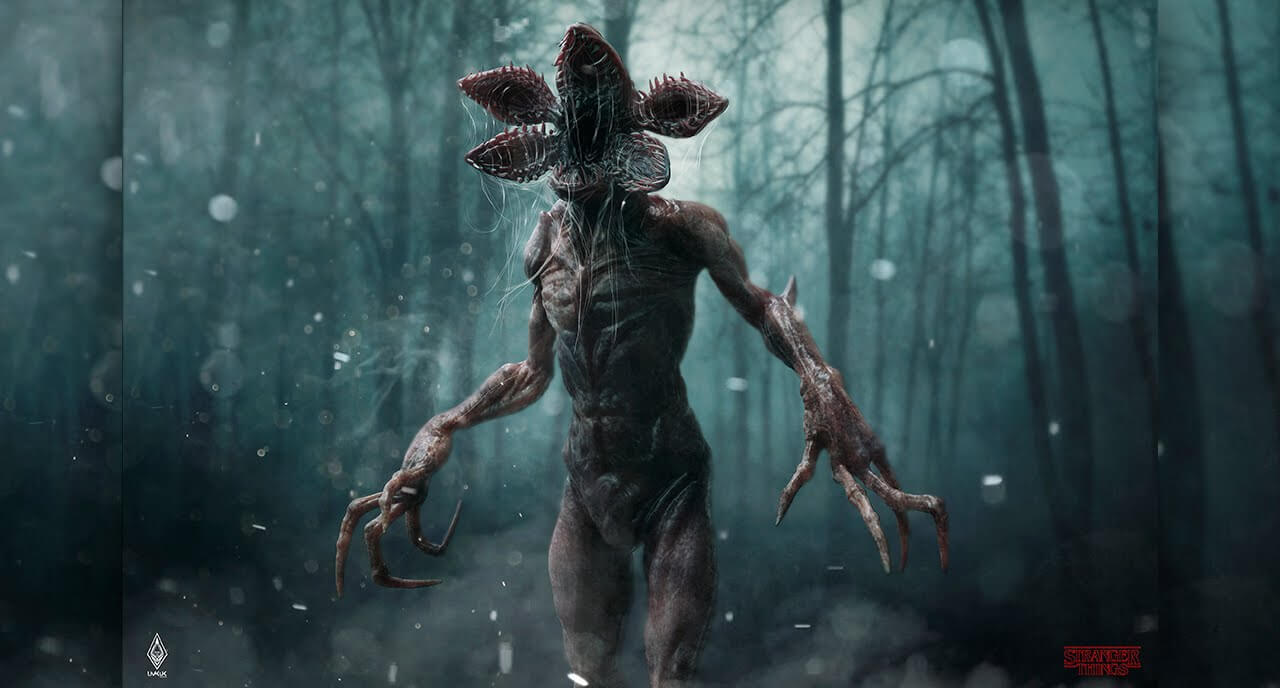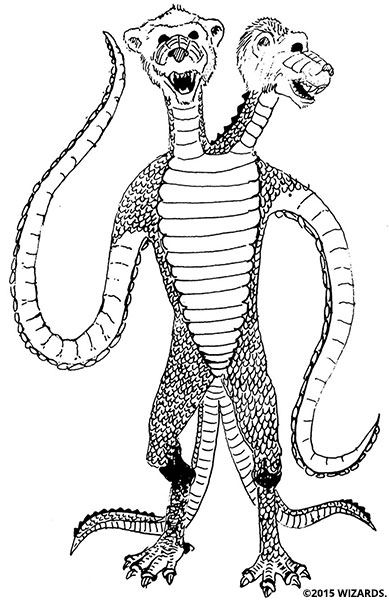|
|

So, I bought the D&D Stranger Things Starter Set, and I was all kinds of excited to run it. I read through it a few times, thought “hmmm…” about some of the choices, but overall it reads like a fairly straightforward adventure.
Warning: This is a super-spoilery blog post. Like, I am delving into this module and its weaknesses. If you are planning to play this adventure, stop reading now.
Let me start with the box set’s production, aka what’s in the box:

- The adventure, Hunt for the Thessalhydra. More on that below.
- The Starter Rules, which include character creation, equipment and magic items, spells, and monsters from the adventure.
- 5 pregenerated PCs at level 3. They’re made using the point-buy rules. They are fairly straightforward. A paladin, a cleric, a bard, a wizard, and a ranger.
- 2 miniatures of the “demogorgon,” which is the monster from Stranger Things Season 1, and not the classic demogorgon monster from early editions of D&D. One of these miniatures is vaguely painted. The other is not, and the quality is not awesome. PCs only encounter one demogorgon in the adventure, so there is no need for two miniatures.
Things I felt would have been good additions to this box:
- Tokens for the other monsters in the adventure.
- Tokens or minis for the 5 pre-gen characters.
- A token or mini for the Thessalhydra! This is the big-bad-boss monster of the adventure, and there was nothing to represent it during the fight.
- Splitting out the monster section from the rest of the Starter Rules so that the GM could have the monster stats in front of her while the players referenced the spells.
The things I went “hmmm” about most were the choice of having the same monster appear several times in more than one place, the random maze, and the unhittable princess.
In short, it reads a lot like an adventure my 12 year old self would write. Which would be fine if this were, in fact, written by the fictional Mike Wheeler from Stranger Things.
But it’s not. It’s meant as an introduction to Dungeons & Dragons, and today, in a world where we have so many excellent adventures available, this one’s weaknesses really stand out and make it a poor representative of D&D.
I ran half of the adventure for a group of 3 female players. All had played an RPG before, but not D&D. None were Stranger Things fans. 2 were teenagers. I say half because I ran out of time, despite playing for about 4 hours. Here’s what happened:
- They have the initial interview/quest-giving with the local lord, who charges them to find and kill the Thessalhydra.
- They went to various local bars, splitting up to find clues.
- They followed clues to the troglodyte caverns. They rolled just under what they needed to find the caverns, and on a failure, they encounter a group of trogs on their way back from hunting. Cue fight sequence, which should have alerted the troglodytes inside the caverns (they used a very noisy spell), but I decided to handwave that because dying in the first fight seemed pointless.
- They enter the caverns and wander around a bit.
- They encounter a group of trogs who run away, into the next room.
- The next room has the troglodyte king, who speaks Common and leads them to the Cursed Labyrinth to find the Thessalhydra.
- They wander around the Cursed Labyrinth endlessly until I gave up and said they found the Lost Knight. It was bedtime at that point, so we ended the session.
The troglodyte fight was nearly lethal to the level 3 wizard in round 1 due to multiattack. Disadvantage in sunlight helps, but only if you fight them in sunlight (fortunately, the first fight was outdoors). And there are so. many. troglodytes. This fight is also not required in the adventure– it’s only if they fail their nature check that it even happens.
The worst part of the session was the Cursed Labyrinth. This is a randomly-generated maze using a random table. There is a 3 in 20 chance of a “Special Encounter.” Otherwise, the results are some description of a hallway, how far it goes, and which direction it turns. The Special Encounters are also a random table, where you have a 1 in 6 chance of encountering the Lost Knight. Encountering the Lost Knight and solving his riddles is the only way to leave the Cursed Labyrinth. For some reason, the Lost Knight is trapped in the labyrinth, even though he is the only one who knows how to get out of it.
When you do the math on the Cursed Labyrinth, your party would, on average, need to go through about 40 randomly-generated (but otherwise barren) hallways before encountering the Lost Knight. In that time, they might also encounter 1 or 2 other Special Encounters which would provide some variety to the endless hallway descriptions.
I recommend changing the labyrinth entirely. Mazes are bad in D&D games, and random mazes are worse. They seem like a great idea when you are a brand new GM, but they are actually just confusing and boring.
Instead, run the labyrinth as a montage of confusing passageways that disappear when you turn around. Have the players describe using skills, spells, and clever thinking to get through the maze, but do not randomly generate your maze’s map. Put more than the Lost Knight in there to interact with– perhaps there are merchants selling trinkets to the lost and lonely, perhaps there are monsters, perhaps there are just interesting traps and puzzles. Make it feel like the oubliette in the movie Labyrinth— a confusing space that constantly changes, but which isn’t, at the very least, ever boring. And finally, when they do encounter the Lost Knight and solve his riddles, give a reason for why he can’t also leave (perhaps he is dead when he leaves, in which case having him follow them would be an interesting and poignant moment).
OK, that is literally as far as we got in a 4 hour session. Nobody was terribly interested in continuing the story, which is telling. When I run games for my niece and her friends, there is usually some desire to return to the adventure if they can– this time, there was nothing.
The Lost Knight helps the PCs get to the Upside Down, where they are now even more lost than ever, and the demogorgon is here.
There is an NPC called the Proud Princess in this adventure whose plot armor is literally impregnable. She’s immune to damage and can’t be hit except with a critical hit. It’s…. I don’t know what to say about this, except it’s bad writing to have an NPC like this. She has knowledge, which is great– but she is so powerful, no party in their right minds would ignore the opportunity to try and convince her to go with them and aid them in their own quest. She is the Elminster of this adventure. She exists only to give them information on how to summon the demogorgon and how to reach the thessalhydra. And so, I suggest that rather than find this information here, perhaps they find a book in the labyrinth. Or have some knowledge from their arcana or nature skills in the party.
Anyway, she tells them how to get to the thessalhydra.
In the last portion of the adventure, the PCs reach the lair of the thessalhydra– which it turns out to live near the local lord’s castle, and they probably could have found it because it does, in fact, leave tracks in the dirt when it goes in and out of its cave.
They went to the troglodyte cavern and the Upside Down for absolutely nothing. OK, then. I don’t think it would be too hard to change the thessalhydra’s lair to somewhere inside the Upside Down, with a portal to an area near the castle. Perhaps, early in the adventure, the PCs could even have found tracks that lead to a tree and then disappear entirely– a foreshadowing of the fact that the thessalhydra is shifting back and forth (and a much better tie-in to the Stranger Things universe).
The thessalhydra has a small tribe of troglodytes what worship it. I’d change these to any other small monstrous humanoid, because there was already a sizeable troglodyte group in the first part of the adventure. And the thessalhydra is a tough monster to fight and kill– make sure the PCs are facing it without also facing the troglodytes (even though the trogs’ job is to guard the thessalhydra!) Putting the thessalhydra inside the Upside Down to fight would achieve this goal handily.
Were I to run this again– and I likely will run it again– I would heavily change the cursed labyrinth. I’d certainly change the princess (perhaps make her incorporeal) and probably make the lost knight someone who leaves with them and turns to dust when he does or something. And because I’m frustrated by D&D’s “crunch,” I’d probably run it with a different, more narrative system. I don’t think this is a great starter to RPGs in general, and I don’t think it’s even a good introduction to Dungeons & Dragons. However, with a lot of tweaking, a good DM can save this module.
